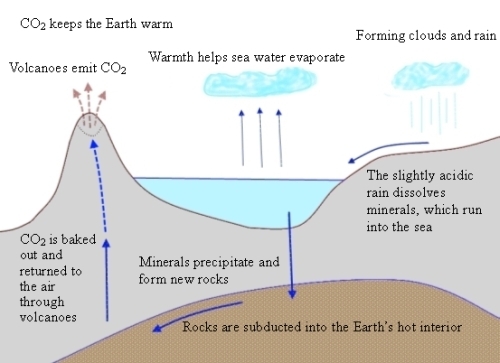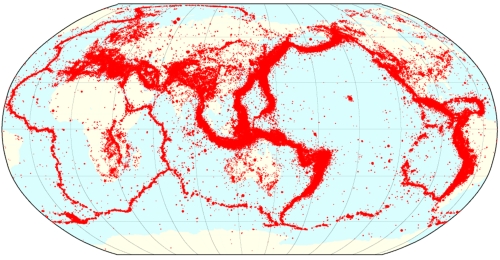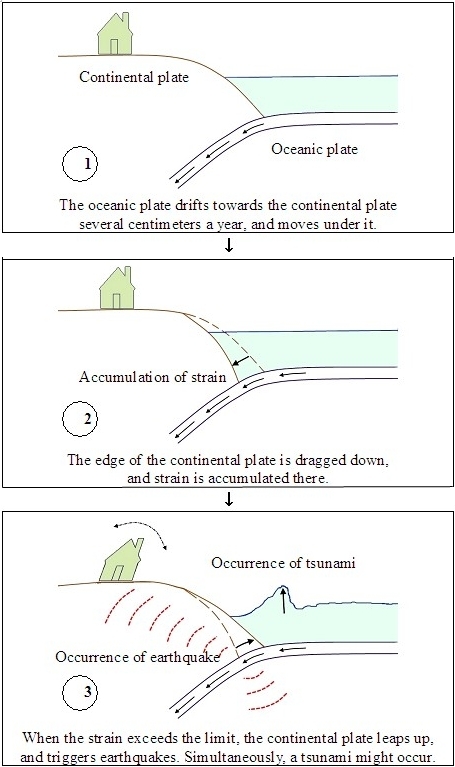What have earthquakes to do with the Earth's climate?
What have earthquakes to do with the Earth's climate?
LEE Boon-ying
Is there any connection between earthquakes and the Earth's climate?
The Earth's climate is related to earthquakes, carbon dioxide and the oceans.
The cycle begins with volcanoes releasing carbon dioxide into the air. As we all know, carbon dioxide as a major greenhouse gas keeps the Earth warm (otherwise, the Earths temperature will drop from an average of about 15 degrees Celsius to a staggering -18 degrees Celsius!). This warmth encourages evaporation from seawater, which in turns produces clouds and rain. The rain is slightly acidic because it contains dissolved carbon dioxide. The acidity causes rock erosion on the Earths surface and rain washes the dissolved minerals into rivers and the sea. Carbon is in general present in the minerals as these could once be living organisms over the aeons. Once onto the sea, the minerals eventually end up as sediments, and then as rocks, on the bottom of the sea. The very slow action of plate tectonics renders these rocks subducted into the Earth mantle, where the carbon dioxide is released because of the immense heat from the Earths interior. The carbon dioxide later returns to the atmosphere through the volcanoes. This completes the cycle.

Figure 1
The moon plays a part in reducing the wobble of the Earth axis, as ven small wobbles causing the Earth axis to tilt wildly can easily bring ice ages.
Together, the above two factors have rendered the Earth's climate reasonably stable for the past 4 billion years, making it habitable by organisms (and later on, by animals including dinosaurs, and still later, by human beings).
The increase in the burning of fossil fuels since the start of industrial age 200 years ago, especially over the past 30 years, has resulted in a significant increase of carbon dioxide in the air and started the global warming we are now facing. This has disrupted the normal cycle. Scientists figure that the atmospheric carbon dioxide and the changed climate are here to stay for many, many years, long after human beings are gone.
What is plate tectonics?
Our knowledge about earthquakes took a big leap when a world-wide seismological network was set up in the early 1960's. When an earthquake occurs, it sends off vibrations (or waves) in all directions. An earthquake wave arrives at the seismological stations at different times. The time differences enable the earthquake to be located.
Thus, it becomes possible to draw up an earthquake map similar to Figure 2 below. It can be seen from the figure that the earthquake locations more or less mark the boundaries of huge plates. The Earth's crust is made up of a dozen or more masses called tectonic plates. Some of these plates are almost stationary, while others may be moving several centimetres a year. Most of the world's earthquakes occur at the boundaries of these plates where they rub, grind, or move under or over each other.

Figure 2 - World Seismicity Map 1964-2008 by International Seismological Centre (ISC) (adopted from "International Seismological Centre (ISC): Current Status & Plans" by Dmitry Storchak, István Bondár, James Harris & Oriol Gaspa)
What is a subduction?
A subduction is an area where two tectonic plates rub, grind, and move under or over each other. The typical rate of movement is measured in centimeters per year. This stores up a large amount of energy. The energy is released when the limit is exceeded, and a rupture occurs. Figure 3 shows the mechanism of a submarine earthquake, and also explains the occurrence of tsunami.

Figure 3
An oceanic plate is more dense than a continental plate. For this reason, an oceanic plate ordinarily slides underneath a continental plate.
Are earthquakes connected with local volcanoes?
The subduction described above sometimes creates a volcanic arc. As an example, the Pacific Rim is characterized by active volcanoes and earthquakes. Volcanic arcs are present in places such as Japan, the Philippines, the Aleutian Islands, and the western coasts of the Americas. The subduction mechanism (see Figure 3) helps to explain why volcanoes are often displaced from earthquake locations.
Note that earthquakes are not always connected with local volcanoes. There are many places in the world where earthquakes are not associated with volcanoes. In other words, a subduction does not necessarily give rise to volcanoes.
Reference:
[1] New Scientist, Sep 2008, p.34.
[1] New Scientist, Sep 2008, p.34.